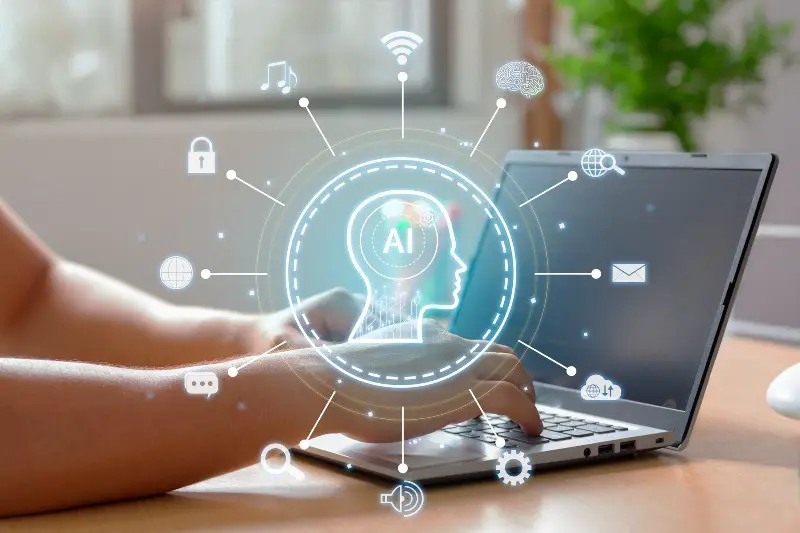Artificial Intelligence (AI) is like the secret spice in a complex recipe, subtly enhancing flavors and creating a unique taste. Its interaction with data science is similarly fascinating and intricate. It’s a relationship that’s breathing new life into how organizations understand their customers, streamline operations, and make strategic decisions.
As we begin this exploration, we will delve into various aspects of this relationship – from AI’s role in data analysis to how it is revolutionizing data science, its influence on big data, predictive analytics, and its impact on data privacy and security. We will share real-life stories that underscore the immense potential and challenges that AI presents in the realm of data science.
By the end of this journey, professionals and enthusiasts alike will gain fresh perspectives on the transformative potential of AI in data science, underscored by powerful narratives and detailed insights. So, let’s begin our voyage into this exciting domain.
Which of the following industries commonly requires data entry tasks?
Understanding the Role of AI in Data Analysis
As the dawn breaks over a busy metropolis, there is one constant that hums in the background, sometimes unnoticed, but always present – data. Every transaction, every digital interaction, every movement is a potential data point. But raw data in itself is a vast, uncharted ocean. AI plays the role of the experienced sailor, navigating these waters, uncovering patterns and insights that would otherwise remain hidden.
AI, particularly machine learning, can comb through complex datasets, identifying patterns that humans may overlook. This AI-driven data analysis is vital in numerous fields – from predicting weather patterns to understanding consumer behavior. Google’s AI-powered flood forecasting is an example of how AI is being used to analyze vast amounts of data to predict potential disasters.
How AI is Transforming the Field of Data Science
In the realm of data science, AI is more than just a tool – it’s a catalyst for transformation. It is redefining how we understand data, making it possible to derive insights from unstructured data such as images, voice, and text. One such transformative story is that of Zillow. Zillow’s Zestimate tool uses AI to analyze unstructured data like photos to estimate home values, revolutionizing real estate market analysis.
At the same time, AI is automating labor-intensive tasks in data science, such as data cleaning and preprocessing. This automation not only saves time but also helps reduce human error, making data science more efficient and accurate.
Defining AI’s Place in Big Data
As data continues to grow exponentially, AI’s role in managing, analyzing, and extracting value from this ‘Big Data’ is becoming increasingly significant. With machine learning algorithms, AI can process large datasets quickly and efficiently, revealing insights that can guide business strategies, predict trends, and optimize processes.
A case in point is Netflix, which uses AI to analyze the viewing habits of its millions of subscribers. This AI-driven analysis helps Netflix recommend personalized content, enhancing user experience, and improving customer retention. This use of AI in the realm of Big Data has helped Netflix stay ahead in the highly competitive streaming industry.
Artificial Intelligence and Deep Learning with Python
Are you wearied by deep learning resources that don’t clarify every single line of code? “Artificial Intelligence and Deep Learning with Python” revolutionizes the way deep learning, AI, and Python are introduced to beginners. The author draws an insightful analogy, equating a computer language with any other language, asserting that understanding every component of a sentence or a line of code is vital to generate novel ones. Unlike other resources claiming to be for “beginners”, this book stands out by dissecting and explaining every line of code.
There’s nothing more perplexing than encountering an unexplained line of code after an initially well-explained one. This book ensures a seamless learning journey with comprehensive explanations for each line of code in every project discussed, along with detailed insights into deep learning and AI concepts. Whether you’re a Python novice or a seasoned programmer, this book will guide you through the intriguing applications of Python in diverse AI and deep learning projects.
You’ll dive into captivating projects and topics, including:
- Deep learning applications in audio/music and voice recognition
- Neural network implementations with image files
- Creating an algorithm for predicting stock prices
- Applying AI through Thompson sampling
- Using deep learning for crime statistic predictions
- Binary classification with neural networks
- Building a Convolutional Neural Network (CNN) for your image files
- Teaching your computer to “read” and “comprehend” the English language
- SQL integration with neural networks
About the author: Steven D’Ascoli, an adjunct professor at St. John’s University, is renowned for his multi-disciplinary expertise.
The Confluence of AI and Predictive Analytics
Predictive analytics has traditionally relied on statistical models to predict future trends based on historical data. However, the advent of AI has introduced a paradigm shift in this field. Machine learning algorithms can now process a broader range of data, including unstructured data, and adapt to changing trends in real-time.
For example, Salesforce uses AI-powered predictive analytics to provide its users with sales forecasts, enabling them to identify opportunities and risks ahead of time. Salesforce’s Einstein AI platform learns from historical sales data, identifies patterns, and predicts future outcomes, proving invaluable for sales teams navigating unpredictable markets.
The Impact of AI on Data Privacy and Security
While AI’s potential in data science is awe-inspiring, it also presents certain challenges, particularly in the realms of data privacy and security. On the one hand, AI can enhance security by detecting and preventing cyber threats. On the other, it can also be used to breach security systems or violate privacy through sophisticated data mining.
For instance, IBM’s Watson for Cyber Security uses AI to detect and counter cyber threats. However, concerns are growing over potential misuse of AI, with algorithms capable of identifying individuals even from anonymized data, raising serious privacy issues.
As AI continues to reshape data science, these ethical and privacy considerations must be addressed. Regulations such as the General Data Protection Regulation (GDPR) and the California Consumer Privacy Act (CCPA) have already set a precedent in this direction, but further measures will likely be needed as AI continues to evolve.
Conclusion
As we have seen, artificial intelligence has permeated virtually every facet of data science, leading to a transformative impact that extends across industries. From enhancing our understanding of data analysis to shaping the future of predictive analytics, AI has proved its significance time and again. It is propelling us towards a future where data-driven decisions can be made with unprecedented accuracy and speed.
However, the rise of AI also brings with it a new set of challenges. These primarily revolve around issues of privacy and security. With AI capable of uncovering layers of insights from data, it becomes imperative to implement safeguards that protect individual privacy and ensure ethical data usage. Thus, while we leverage AI to harness the power of data, we must also tread cautiously to prevent any misuse of this technology.
In a broader perspective, AI’s role in data science signifies a larger trend. It underscores how integral AI has become to our digital landscape. As AI continues to evolve and mature, its impact on data science and other fields will only become more profound. For data science professionals and businesses alike, understanding and harnessing the potential of AI is no longer an option but a necessity.
Looking forward, AI is poised to continue its transformative journey, breaking new ground in data science and beyond. As we embrace this wave of change, we must also adapt, evolve and equip ourselves to navigate this dynamic landscape. The future of AI in data science is not just promising; it’s already here.

Navigating the Convergence: Artificial Intelligence and the Legal Sphere
Artificial Intelligence (AI) has transformed multiple sectors, including the field of law. This blog post delves into the legal aspects of AI, the regulatory landscape, and AI’s role in legal practice. It also explores AI’s impact on privacy law and the ethical quandaries it presents. A comprehensive look at the intriguing intersection of AI and law.





